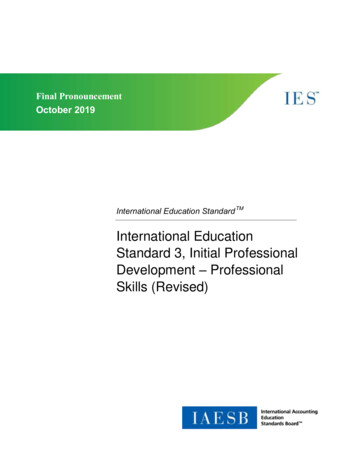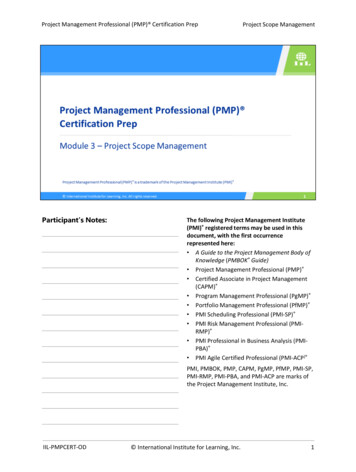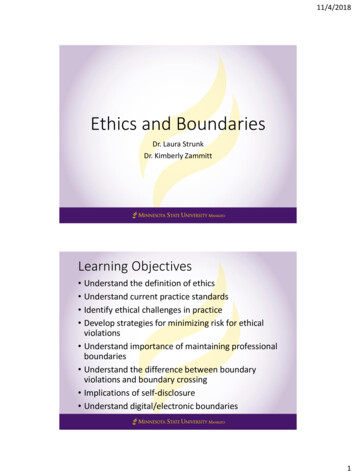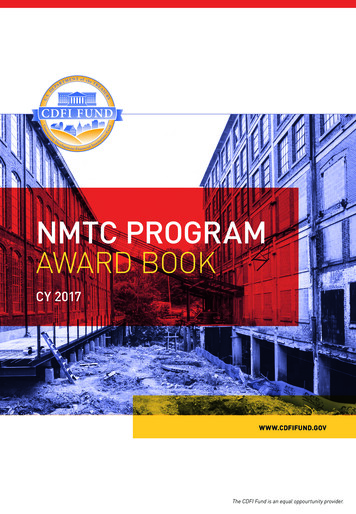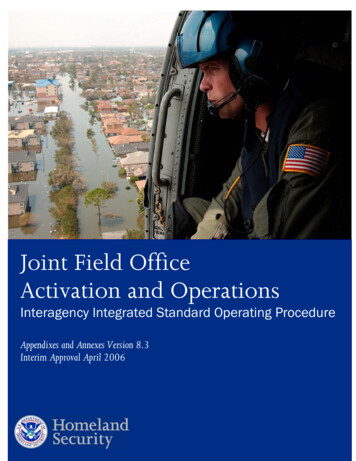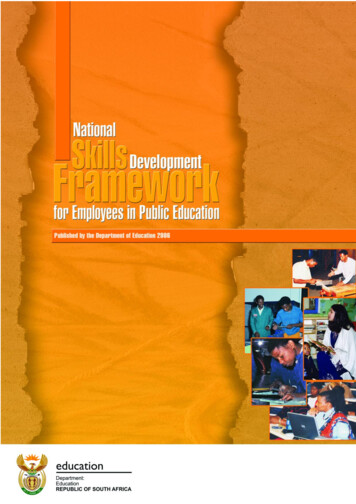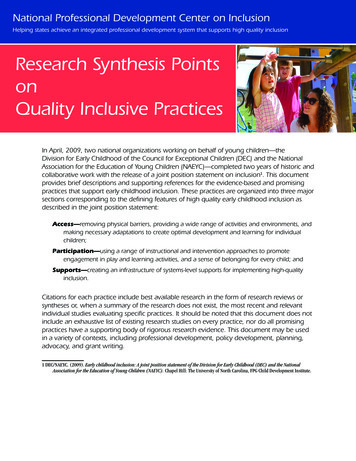
Transcription
National Professional Development Center on InclusionHelping states achieve an integrated professional development system that supports high quality inclusionResearch Synthesis PointsonQuality Inclusive PracticesIn April, 2009, two national organizations working on behalf of young children—theDivision for Early Childhood of the Council for Exceptional Children (DEC) and the NationalAssociation for the Education of Young Children (NAEYC)—completed two years of historic andcollaborative work with the release of a joint position statement on inclusion1. This documentprovides brief descriptions and supporting references for the evidence-based and promisingpractices that support early childhood inclusion. These practices are organized into three majorsections corresponding to the defining features of high quality early childhood inclusion asdescribed in the joint position statement:Access—removing physical barriers, providing a wide range of activities and environments, andmaking necessary adaptations to create optimal development and learning for individualchildren;Participation—using a range of instructional and intervention approaches to promoteengagement in play and learning activities, and a sense of belonging for every child; andSupports—creating an infrastructure of systems-level supports for implementing high-qualityinclusion.Citations for each practice include best available research in the form of research reviews orsyntheses or, when a summary of the research does not exist, the most recent and relevantindividual studies evaluating specific practices. It should be noted that this document does notinclude an exhaustive list of existing research studies on every practice, nor do all promisingpractices have a supporting body of rigorous research evidence. This document may be usedin a variety of contexts, including professional development, policy development, planning,advocacy, and grant writing.1 DEC/NAEYC. (2009). Early childhood inclusion: A joint position statement of the Division for Early Childhood (DEC) and the NationalAssociation for the Education of Young Children (NAEYC). Chapel Hill: The University of North Carolina, FPG Child Development Institute.
Practices that Support AccessUniversal Design (UD)/Universal Design for Learning (UDL)UD and UDL support access to early care and education environments through the removalof physical and structural barriers (UD) and the provision of multiple and varied formats forinstruction and learning (UDL).2National Center on Universal Design for Learning. UDL Guidelines - Version 2.0: ResearchEvidence. Assistive Technology (AT)AT interventions involve a range of strategies to promote a child’s access to learningopportunities, from making simple changes to the environment and materials to helpinga child use special equipment. Combining AT with effective teaching promotes the child’sparticipation in learning and relating to others.3Campbell, P. H., Milbourne, S., Dugan, L. M., & Wilcox, M. J. (2006). A review of evidence onpractices for teaching young children to use assistive technology devices. Topics inEarly Childhood Special Education, 26(1), 3-13.Trivette, C. M., Dunst, C. J., Hamby, D. W., & O’Herin, C. E. (2010). Effects of different types ofadaptations on the behavior of young children with disabilities. Tots n Tech ResearchInstitute. Research Brief 4(1). http://tnt.asu.edu/files/Adaptaqtions Brief final.pdfPractices that Support ParticipationEmbedded Instruction and Other Naturalistic InterventionsEmbedded instruction and intervention strategies address specific developmental or learninggoals within the context of everyday activities, routines, and transitions at home, at school, orin the community.4Snyder, P., Rakap, S., Hemmeter, M.L., McLaughlin, T., Sandall, S., & McLean, M. (2011).Naturalistic instructional approaches in early learning. Manuscript submitted forpublication.Trivette, C. M., Dunst, C. J., Hamby, D. W., & O’Herin, C. E. (2010). Effects of different types ofadaptations on the behavior of young children with disabilities. Tots n Tech ResearchInstitute. Research Brief 4(1). http://tnt.asu.edu/files/Adaptaqtions Brief final.pdf2 No research syntheses or published peer-reviewed studies are available for appraising the evidence related to universal design or universaldesign for learning prior to kindergarten. The citation included is a school-aged example.3 Winton, P. J., Buysse, V., Rous, B., Epstein, D., & Pierce, P. (2010). CONNECT Module 5: Assistive technology interventions. Chapel Hill: TheUniversity of North Carolina, FPG Child Development Institute, CONNECT: The Center to Mobilize Early Childhood Knowledge.4 Winton, P. J., Buysse, V., Turnbull, A., Rous, B., & Hollingsworth, H. (2010). CONNECT Module 1: Embedded interventions. Chapel Hill: TheUniversity of North Carolina, FPG Child Development Institute, CONNECT: The Center to Mobilize Early Childhood Knowledge.2www.fpg.unc.edu/ npdci
Scaffolding StrategiesScaffolding strategies are structured, targeted approaches that can be used with children whorequire more intensive supports across a wide variety of teaching and learning contexts, andin combination with other approaches. Scaffolding strategies include modeling, responseprompting, variations of prompting and modeling, peer supports, and corrective feedback.5, 6Chiara, L., Schuster, J. W., Bell, J. K., & Wolery, M. (1995). Small-group massed-trial andindividually distributed-trial instruction with preschoolers. Journal of EarlyIntervention, 19, 203-217.Craig-Unkefer, L. A., & Kaiser, A. P. (2002). Improving the social communication skillsof at-risk preschool children in a play context. Topics in Early Childhood SpecialEducation, 22, 3-13.Gibson, A. N., & Schuster, J.W. (1992). The use of simultaneous prompting for teachingexpressive word recognition to preschool children. Topics in Early Childhood SpecialEducation, 12, 247-267.Girolametto, L., Weitzman, E., & Greenberg, J. (2004). The effects of verbal supports onsmall-group peer interactions. Language, Speech, and Hearing Services in Schools,35, 254-268.Hawkings, S. R., & Schuster, J. W. (2007). Using a mand-model procedure to teach preschoolchildren initial speech sounds. Journal of Developmental and Physical Disabilities,19(1), 65-80.Kaiser, A. P., Hemmeter, M. L., & Ostrosky, M. M. (1996). The effects of teaching parents touse responsive interaction strategies. Topics in Early Childhood Special Education,16, 375-406.Kaiser, A. P., Hester, P. P., & McDuffie, A. S. (2001). Supporting communication in youngchildren with developmental disabilities. Mental Retardation and DevelopmentalDisability Research Reviews, 7, 143-150.Kouri, T. A. (2005). Lexical training through modeling and elicitation procedures with latetalkers who have specific language impairment and developmental delays. Journal ofSpeech, Language, and Hearing Research, 48, 157-171.Ostrosky, M., & Kaiser, A. P. (1995).The effects of a peer-mediated intervention on thesocial communicative interactions between children with and without special needs.Journal of Behavioral Education, 5(2), 151-171.Ross, D. E., & Greer, R. D. (2003). Generalized imitation and the mand: Inducing firstinstances of speech in young children with autism. Research in DevelopmentalDisabilities, 24, 58-74.Walker, G. (2008). Constant and progressive time delay procedures for teaching childrenwith autism: A literature review. Journal of Autism and Developmental Disorders, 38,261-275.5 Recent and relevant individual studies evaluating specific practices are listed because research reviews, syntheses, orsummaries are not currently available.6 Buysse, V. (2011). Access, participation, and supports: The defining features of high-quality inclusion. Zero to Three, 31(4), 24-31.www.fpg.unc.edu/ npdci3
Tiered Models of Instruction/InterventionTiered models of instruction offer a framework that can be used in early childhood to helppractitioners connect children’s formative assessment results with specific teaching andintervention strategies.7, 8, 9, 10Burns, M. K., Appleton, J. J., & Stehouwer, J. D. (2005). Meta-analytic review ofresponsiveness-to-intervention research: Examining field-based and researchimplemented models. Journal of Psychoeducational Assessment, 23(4), 381-394.Gersten, R., Beckman, S., Clarke, B., Foegen, A., Marsh, L., Star, J. R., & Witzel, B. (2009).Assisting students struggling with mathematics: Response to intervention (RTI) forelementary and middle schools (NCEE 2009-4060). Washington, DC: U.S. Departmentof Education, Institute of Education Sciences, National Center for EducationEvaluation and Regional Assistance. Retrieved from ides/Gersten, R., Compton, D., Connor, C. M., Dimino, J., Santoro, L., Linan-Thompson, S., & Tilly,W. D. (2008). Assisting students struggling with reading: Response to interventionand multi-tier intervention for reading in the primary grades. A practice guide. (NCEE2009-4045). Washington, DC: U.S. Department of Education, Institute of EducationSciences, National Center for Education Evaluation and Regional Assistance. Retrievedfrom ides/Practices Relating to Systems-Level SupportsProfessional Development (PD)PD includes teaching and learning activities designed to support the acquisition of professionalknowledge, skills, and dispositions related to inclusion as well as the application of thisknowledge in practice. The content of the PD should include evidence-based practices thatdefine high-quality early childhood inclusion.11, 12Cochran-Smith, M., & Zeichner, K. (2005). Executive summary. In M. Cochran-Smith & K.M. Zeichner (Eds.), Studying teacher education: The report of the AERA panel onresearch and teacher education (pp. 1-36). Mahwah, NJ: Erlbaum.Trivette, C. M., Dunst, C. J., Hamby, D. W., & O’Herin, C. E. (2009). Characteristics andconsequences of adult learning methods and strategies. Winterberry ResearchSynthesis, 2(2). Retrieved from http://www.signetwork.org/content page assets/content page 66/adult%20learning%20Trivette%20and%20Dunst.pdf7 Buysse, V., & Peisner-Feinberg, E. (2010). Recognition & response: RTI for pre-k. Young Exceptional Children, 13(4), 2–13.8 Hemmeter, M. L., Ostrosky, M., & Fox, L. (2006). Social and emotional foundations for early learning: A conceptual model for intervention.School Psychology Review, 35(4), 583-601.9 Greenwood, C. R., Bradfield, T., Kaminski, R., Linas, M. W., Carta, J. J., & Nylander, D. (2011). The response to (RTI) approach in earlychildhood. Focus on Exceptional Children, 43(9), 1-22.10 No research syntheses or published peer-reviewed studies are available for appraising the evidence of tiered models of instruction/interventionand to monitor progress in young children prior to kindergarten. The citations included are school-aged examples.11 National Professional Development Center on Inclusion. (2008). What do we mean by professional development in the early childhood field?Chapel Hill: The University of North Carolina, FPG Child Development Institute, Author.12 Because very few syntheses address professional development in early childhood, most of these citations are drawn from studies acrossdifferent ages, disciplines, and content areas.4www.fpg.unc.edu/ npdci
Wei, R. C., Darling-Hammond, L., Andree, A., Richardson, N., & Orphanos, S. (2009).Professional learning in the learning profession: A status report on teacherdevelopment in the United States and abroad. Dallas, TX: National StaffDevelopment Council.Whitehurst, G. J. (2002, March 5). Research on teacher preparation and professionaldevelopment. Address to the White House Conference on Preparing Tomorrow’sTeachers. Retrieved from teachersconference/whitehurst.htmlZaslow, M., Tout, K., Halle, T., Whittaker, J. E., & Lavelle, B. (2010). Toward the identificationof features of effective professional development for early childhood educators:Literature review. Washington, DC: US Department of Education.Models of CollaborationA variety of approaches have been developed to support ongoing communication andcollaboration in conjunction with quality improvement and professional development in earlychildhood (and education more broadly). These include technical assistance, consultation,coaching, mentoring, collaborative problem-solving, and communities of practice/professionallearning communities.13Sheridan, S. M., Welch, M., & Orme, S. F. (1996). Is consultation effective? A review ofoutcome research. Remedial and Special Education, 17(6), 341-354.Family-Professional CollaborationFamily-professional collaboration builds opportunities for both relationship building and theactive participation of parents and practitioners in achieving mutually agreed upon goals.The collaborative efforts build and strengthen family and professional capacity to provide ormediate the provisions of resources, supports, and services that ensure inclusion of childrenwith disabilities in typical school and community activities.14,15Dunst, C. J., & Trivette, C. M. (2009). Meta-analytic structural equation modeling ofthe influences of family-centered care on parent and child psychological health.International Journal of Pediatrics, 2009, 1-9.Dunst, C. J., Trivette, C. M., & Hamby, D. W. (2007). Meta-analysis of family-centeredhelpgiving practices research. Mental Retardation and Developmental DisabilitiesResearch Reviews, 13(4), 370-378.Trivette, C. M., Dunst, C. J., & Hamby, D. W. (2010). Practices on parent-child interactionsand child development. Topics in Early Childhood Special Education, 30(1), 3–19.13 No research syntheses or published peer-reviewed studies are available for appraising evidence related to using models of collaboration withpersonnel serving young children prior to kindergarten. The citation included is a school-aged example.14 Dunst, C. J., Trivette, C. M., & Snyder, D. M. (2000). Family-professional partnerships: A behavioral science perspective. In M.J. Fine & R.L.Simpson (Eds.), Collaboration with parents and families of children and youth with exceptionalities (2nd ed., pp. 27-48). Austin, TX:Pro-Ed.15 Turnbull, A., & Turnbull, R. (2010). Families, professionals, and exceptionality: Positive outcomes through partnerships and trust (6th ed.).Upper Saddle River, NJ: Merrill Prentice Hall.www.fpg.unc.edu/ npdci5
Suggested CitationNational Professional Development Center on Inclusion.(2011). Research synthesis points on practices thatsupport inclusion. Chapel Hill: The University of NorthCarolina, FPG Child Development Institute, Author.Available athttp://community.fpg.unc.edu/npdciNPDCI acknowledges and deeply appreciates the contributions of the following colleagues to this resource: Mary Jane Brotherson, Virginia Buysse, Pip Campbell, Judy Carta, Camille Catlett, JohnnaDarragh Ernst, Shelley deFosset, Laurie Dinnebeil, Heidi Hollingsworth, Marilou Hyson, AnnKaiser, Bill McInerney, Robin McWilliam, Suzanne Milbourne, Pat Snyder, Carol Trivette, TraceyWest, Pam Winton, and Mark Wolery.Permission to copy not required—distribution encouraged.FPG is one of the nation’soldest multidisciplinarycenters devoted to the studyof children and families.Our mission is to cultivateand share knowledge thatenhances child developmentand family well being.FPG.Advancing knowledge.Enhancing lives.6www.fpg.unc.edu/ npdci
National Professional Development Center on Inclusion Helping states achieve an integrated professional development system that supports high quality inclusion
